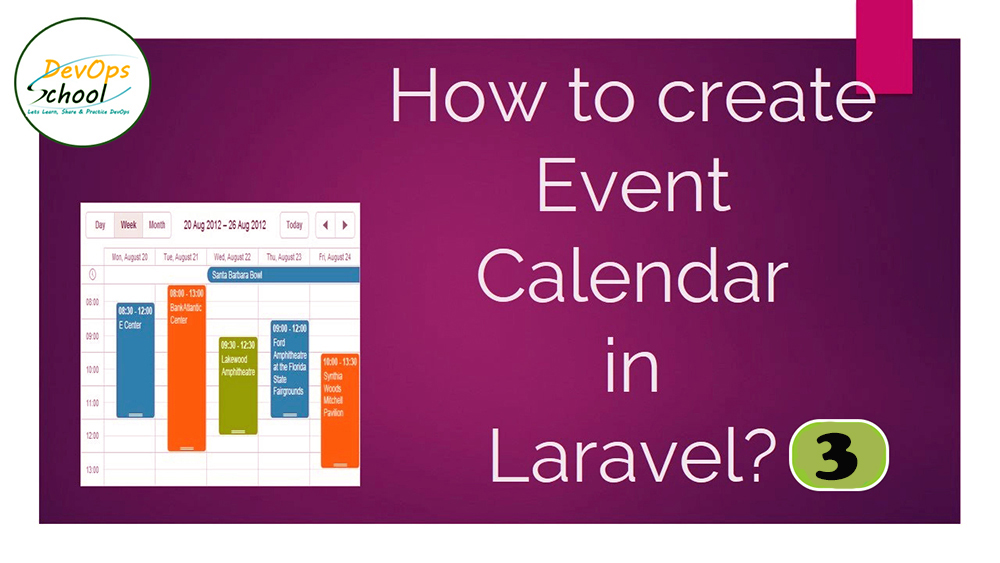
Step 1.Create a Database in phpMyAdmin.
(Write the same name of database which was written in .enf databse name).

Step 2. We use the migrate command to create the column in the database.
$php artisan migrate
Step 3. Create Controller with methods.
On this step, we want to make a new controller for Event Calendar operations in Laravel Application. After creating a controller file we need to define a method and handling function in it.
| namespace App\Http\Controllers; | |
| use Illuminate\Http\Request; | |
| use App\Event; | |
| use MaddHatter\LaravelFullcalendar\Facades\Calendar; | |
| use DB; | |
| use Illuminate\Support\Facades\Redirect; | |
| class EventController extends Controller | |
| { | |
| /** | |
| * Display a listing of the resource. | |
| * | |
| * @return \Illuminate\Http\Response | |
| */ | |
| public function index() | |
| { | |
| $events = []; | |
| $data = Event::all(); | |
| if($data->count()) | |
| { | |
| foreach ($data as $key => $value) | |
| { | |
| $events[] = Calendar::event( | |
| $value->title, | |
| true, | |
| new \DateTime($value->start_date), | |
| new \DateTime($value->end_date.'+1 day'), | |
| null, | |
| // Add color | |
| [ | |
| 'color'=> $value->color, | |
| 'textColor' => $value->textColor, | |
| ] | |
| ); | |
| } | |
| } | |
| $calendar =\Calendar::addEvents($events); | |
| return view('eventpage',compact('events','calendar')); | |
| } | |
| /** | |
| * Show the form for creating a new resource. | |
| * | |
| * @return \Illuminate\Http\Response | |
| */ | |
| public function display() | |
| { | |
| return view("addevent"); | |
| } | |
| public function create() | |
| { | |
| // | |
| } | |
| public function store(Request $request) | |
| { | |
| $request->validate([ | |
| 'title'=>'required', | |
| 'color'=>'required', | |
| 'start_date'=>'required', | |
| 'end_date'=>'required', | |
| ]); | |
| $events=new Event; | |
| $events->title=$request->input('title'); | |
| $events->color=$request->input('color'); | |
| $events->start_date=$request->input('start_date'); | |
| $events->end_date=$request->input('end_date'); | |
| $events->save(); | |
| return redirect('eventpage')->with('success','Event Added'); | |
| } | |
| public function show() | |
| { | |
| $events = Event::all(); | |
| return view('display')->with('events',$events); | |
| } | |
| public function edit($id) | |
| { | |
| $events = Event::find($id); | |
| return view('editform',compact('events','id')); | |
| } | |
| public function update(Request $request, $id) | |
| { | |
| $events = Event::where('id', '=', $id)->first(); | |
| $events->update($request->all()); | |
| return redirect('eventpage')->with('success','Event Updates Successfully'); | |
| } | |
| /** | |
| * Remove the specified resource from storage. | |
| * | |
| * @param int $id | |
| * @return \Illuminate\Http\Response | |
| */ | |
| public function destroy($id) | |
| { | |
| $events = Event::find($id); | |
| $events->delete(); | |
| return redirect('/editeventurl'); | |
| } | |
| } |

Store function is used to store the data.


Destroy function is used for delete the data

In Part 4, we will see how to make blade.php file?
Click Here — https://www.devopsschool.com/blog/how-to-create-event-calendar-in-laravel-part-4/
I’m a DevOps/SRE/DevSecOps/Cloud Expert passionate about sharing knowledge and experiences. I am working at Cotocus. I blog tech insights at DevOps School, travel stories at Holiday Landmark, stock market tips at Stocks Mantra, health and fitness guidance at My Medic Plus, product reviews at I reviewed , and SEO strategies at Wizbrand.
Please find my social handles as below;
Rajesh Kumar Personal Website
Rajesh Kumar at YOUTUBE
Rajesh Kumar at INSTAGRAM
Rajesh Kumar at X
Rajesh Kumar at FACEBOOK
Rajesh Kumar at LINKEDIN
Rajesh Kumar at PINTEREST
Rajesh Kumar at QUORA
Rajesh Kumar at WIZBRAND

 Starting: 1st of Every Month
Starting: 1st of Every Month  +91 8409492687
+91 8409492687  Contact@DevOpsSchool.com
Contact@DevOpsSchool.com
 by
by 